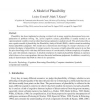Free Online Productivity Tools
i2Speak
i2Symbol
i2OCR
iTex2Img
iWeb2Print
iWeb2Shot
i2Type
iPdf2Split
iPdf2Merge
i2Bopomofo
i2Arabic
i2Style
i2Image
i2PDF
iLatex2Rtf
Sci2ools
COGSCI
2006
2006
A Model of Plausibility
Plausibility has been implicated as playing a critical role in many cognitive phenomena from comprehension to problem solving. Yet, across cognitive science, plausibility is usually treated as an operationalized variable or metric rather than being explained or studied in itself. This article describes a new cognitive model of plausibility, the Plausibility Analysis Model (PAM), which is aimed at modeling human plausibility judgment. This model uses commonsense knowledge of concept
| Added | 11 Dec 2010 |
| Updated | 11 Dec 2010 |
| Type | Journal |
| Year | 2006 |
| Where | COGSCI |
| Authors | Louise Connell, Mark T. Keane |
Comments (0)

